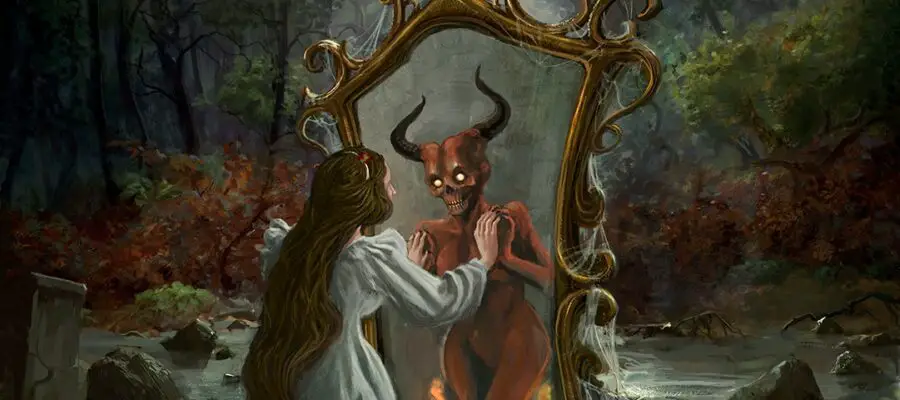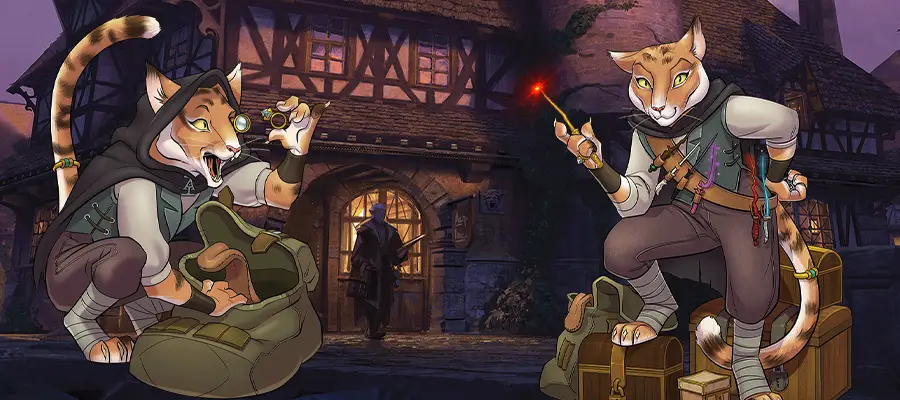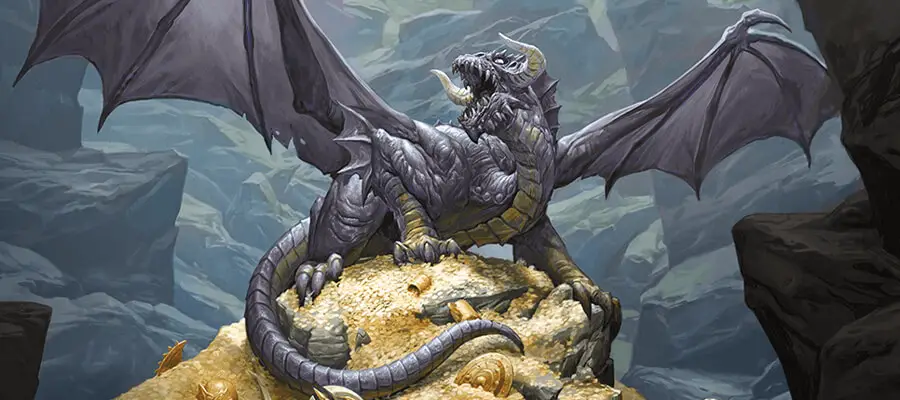Mirrored by Sanskarans, Creative Commons Attribution-Noncommercial-No Derivative Works 3.0 License
This site contains affiliate links that add gold to our coffers.
One of the least-understood game mechanics, in my opinion, is the Frightened condition. Players and DM’s are typically uncertain of what it means for a creature to be Frightened, looking up the rule in the moment to find out how fear will affect the game. Beyond mechanics, fear is not roleplayed very well, if at all. If a player isn’t scared, I don’t typically see them empathizing with their Frightened characters. Players just want to get their characters to snap out of it so they can fight optimally. I think this is an unfortunate paradigm regarding in-game fear; a player that truly gets into a character’s head can experience the game emotionally, feeling genuine dread on behalf of their characters. DM’s dream of genuinely frightening players, but they’ll settle for a session roleplayed well.
Since fright can be expressed and mechanized with greater potency in 95% (ish) of D&D games, I’ve decided to write about it. As you read, consider how you can roleplay fright and strategically use it. This also applies to instilling dread that isn’t mechanical, not a condition. DM’s aren’t exempt from this message because they need to learn how to make their NPC’s scared sometimes instead of always expressing smugness towards the players even while at death’s door.
Mechanics
The Frightened condition mechanically causes the following to happen:
- A Frightened creature has disadvantage on Ability Checks and Attack rolls while the source of its fear is within line of sight.
- Flutes speaking: This does not mean you can avoid disadvantage by turning your eyes away from the source of your fear. Line of sight is a game mechanic that really means a clear path.
- The creature can’t willingly move closer to the source of its fear.
Additionally, the Frightened condition is similar to the Charmed condition in that spells and effects that cause it often have added effects while the creature is Frightened. One example is the Fear spell which causes its targets to drop what they’re holding, plus the Frightened condition’s roll-disadvantage and movement-hindrance effects.
Now that we’ve reviewed the mechanics, I’m temporarily setting mechanics aside to muse about roleplaying fear in tabletop roleplaying games.
Roleplaying Dread
First of all, a disclaimer: you may have personal experiences that you don’t want to emotionally summon while you’re playing a frivolous game of D&D with friends. I’m not recommending that you dig up personal ghosts if it will cause you mental anguish. Roleplaying should be fun, and it shouldn’t require you to have literally experienced the kind of fear your character feels. With that in mind, I’ll proceed with my thoughts for getting creative.
How do you roleplay a character that feels fear when you, the player, are not afraid? This will obviously require creativity. Famous psychologist Carl Jung once said, “It all depends on how we look at things, and not how they are in themselves.” Fear is based on perceptions of the mind, not the concept being feared. The Frightened condition can be a genuine experience of dread, or an illusory idea placed in someone’s head. Roleplaying fear involves an understanding or assumption of whether a character is experiencing genuine fear or forced dread (such as from a spell). Certain monsters have abilities that cause characters to become Frightened, and I like to think of these effects as genuine rather than magically imposed.
Presenting genuine dread involves an understanding of a character’s flaws, hopes, loves, and failures. These are concepts you may reference to portray a character in a state of fear. Fear of loss can cause fearful behavior like bargaining, self-preservation, aggression, and more. I’d be careful with choices you make with this portrayal concept because you don’t want to get the party killed (other players won’t admire your devotion to roleplaying if it ruins the game for them). Nobody will feel better if their character died because you were “just doing what my character would do.”
Instead of making dumb decisions, your character could actually become uncharacteristically hyper-focused. Fear can be portrayed through heightened senses, greater feelings of responsibility, and general growth. There was a Halloween episode of The Office that was based on fear as the characters celebrated Halloween. One by one, characters realized what mattered most to them because of what they feared, followed by them making decisions that would help them take care of those they held dear. The episode ended with this insightful quote from Robert California: “Fear plays an interesting role in our lives. How dare we let it motivate us? How dare we let it into our decision making, into our livelihoods, into our relationships? It’s funny isn’t it we take a day a year to dress up in costume and celebrate fear.” It’s ok to not let fear force your character to their knees. Use fear as an opportunity to show your group a side of your character that they’ve never seen before.
I’ll alternatively assume that you’ll occasionally want to have your character lose it when they’re Frightened. Please don’t scream at the table. You might think you’re part of a group that will embrace your screaming, but I bet you’re wrong. Swearing also feels like a cop out unless you pick curses that don’t already come out of your mouth once every ten minutes. Try picking out interesting, entertaining, or even funny phrases that your character can say in moments of fear and peril. Instead of screaming, you can portray your character’s fright by beginning to speak quickly while breathing more rapidly (don’t overdo it or you’ll get dizzy, seriously). Implore other characters to listen to you as you put strain into your voice to let them know the character is trying not to cry.
Apart from what you say and how you say it, describe other sensations that we’re all familiar with: clammy hands struggling to grip your sword, shaky knees failing to allow you prideful posture, eyes tensing up as tear ducts pulse with tears, sensing things as if in slow motion as adrenaline circulates your body, feeling your heartbeat in your neck, failing to keep up with a conversation as your thoughts dwell elsewhere, fidgeting with your knife or a ring on your finger, or becoming suddenly aware of smells in the room as you begin to breathe twice as fast. These are sensory descriptions that everyone at your gaming table can relate to, and it might make their hair stand on end as they imagine what your character feels (on that note, goosebumps and hair standing stiff are additional go-to sensory descriptions).
While in a state of dread, describe a character’s reactions to success and failure. When they fail to strike a foe, narrate their eyes going wide as they return to a defensive stance in a panicked clumsy shuffle. Inversely, landing an attack could cause them to exclaim under their breath with a stifled laugh of relief. This goes for your allies too. Your character’s reactions can vary widely depending on how well your allies are helping you fight against whatever is causing you fear.
Now that we’ve talked about rational fear, I’ll point out that magically enhanced fear could feel like a drug induced nightmare. I call your attention to the visions of fear that the Scarecrow’s drugs would induce in the movie Batman Begins. This is fear that causes people to harm themselves and others, and it should be dealt with quickly if your party is subjected to this magical dread. This is not the kind of fear that can make you think quickly and act with deftness; this fear will make you drop your weapons, run away, or even harm yourself as you approach madness. Portray this however you like. The other players can’t fault you for doing what a harmful spell tells you to do. Play it up!
Racial Traits Involving Fright
Shifting focus now to mechanical applications and analyses of the Frightened condition. Several races have traits that interact with fear:
- Halflings have advantage on saving throws against being Frightened thanks to their Brave feature.
- Dragonborn characters can choose a feat called Dragon Fear to switch out their breath weapon to frighten opponents instead of dealing elemental damage.
- Fallen Aasimar cause fear with their Necrotic Shroud ability.
Class Features Involving Fright
Many class features and abilities are designed to cause or combat fear:
- Berserker Barbarians have Mindless Rage that renders the Frightened condition suspended until the Rage ends.
- Berserker Barbarians have a relatively weak ability called Intimidating Presence that causes fright.
- Bards’ Countercharm works against the Frightened condition as well as charms.
- Bards from the College of Whispers can use Words of Terror to frighten enemies.
- Druids of Circle of the Land become immune to the Frightened condition when it comes from elementals and fey creatures.
- Battle Master Fighters can use Menacing Attack maneuvers that involve the Frightened condition.
- Monks have Stillness of Mind to end any Frightened conditions affecting them.
- Paladins’ Aura of Courage prevents nearby allies from becoming Frightened.
- Paladins who swear the Oath of Vengeance can use Channel Divinity: Abjure Enemy to Frighten foes.
- Vengeance Paladins possess a level-twenty transformation ability, Avenging Angel, that imposes fear on enemies.
- The Paladin of Conquest’s abilities and Oath Spells are designed to utilize the Frightened condition, which is a unique focus for a subclass; I wrote an article dedicated to talking about this subclass and its use of fear. It’s so cool, it’s scary!
- Hunter Rangers may choose Defensive Tactics, including Steel Will that grants them advantage on saving throws against the Frightened condition.
- Draconic Presence is a feature of Draconic Ancestry Sorcerers that instills awe and fear in enemies.
- The Archfey will grant Warlocks the Fey Presence ability to potentially frighten enemies, followed by Dark Delirium which also uses fear.
- If a Warlock chooses Pact of the Chain, the Warlock can use a Quasit as a familiar, and the Quasit possesses a fear ability.
Spells That Elicit Fright
- Antipathy/Sympathy (8th-level enchantment) – Additionally forces movement.
- Cause Fear (1st-level necromancy)
- Eyebite (6th-level necromancy) – Additionally forces the Dash action.
- Fear (3rd-level illusion) – Additionally forces dropped items and Dash action.
- Hallow (5th-level evocation)
- Illusory Dragon (8th-level illusion)
- Phantasmal Killer (4th-level illusion) – Additionally inflicts psychic damage.
- Summon Shadowspawn (3rd-level conjuration) – The summoned Shadow Spirit has an ability that causes fear.
- Symbol (7th-level abjuration) – Additionally forces dropped items and movement.
- Weird (9th-level illusion) – Additionally inflicts psychic damage.
- Wrathful Smite (1st-level evocation)
Spells That Counteract Fright
- Aura of Purity (4th-level abjuration)
- Calm Emotions (2nd-level enchantment)
- Dispel Evil and Good (5th-level abjuration)
- Hallow (5th-level evocation)
- Heroes’ Feast (6th-level conjuration)
- Heroism (1st-level enchantment)
- Magic Circle (3rd-level abjuration)
- Power Word Heal (9th-level evocation)
- Protection from Evil and Good (1st-level abjuration)
Frightful Combat Tactics
Spells that inflict fright have an advantage over charm effects; fear effects don’t usually grant additional saving throw attempts when victims take damage. Typical Frightened conditions are predicated on proximity to the source of fear, so once Frightened creatures are far enough away or out of sight, the Frightened condition ends. This might sound like fear is easily overcome, but let’s think about this a moment.
- A creature becomes Frightened.
- On its turn, a creature can’t move closer to the source of fear, and some effects will force movement away from the source of fear. This movement can result in opportunity attacks. If the creature has the choice to stay and fight, it does so with disadvantage on attacks and skill checks. Creatures that Dash may make it far enough away to end the fear, but then they’re far away. Dealing with the Fear spell will be more difficult as distance alone is not enough to end the spell, requiring a Wisdom saving throw once line of sight is broken.
- Being far away means the creatures must decide whether to attack from range, or Dash back to the heat of melee combat. This means the creature effectively lost two turns trying to end the Frightened condition and the spell causing it, and it may have taken damage from attacks of opportunity.
With this three-step timeline in mind, it’s best to get close to your targets when inflicting fright. This will force your targets to take pains to put distance between them and you. Doing this will increase your opponents’ turns and actions wasted while opening them up attacks of opportunity.
Paladins who swear the Oath of Conquest have the potential to make enemies dead in the water since their Aura of Conquest reduces Frightened opponents’ speed to zero. As I previously stated, Frightened conditions are often relieved with distancing rather than repeating saving throws (excluding the Conquering Presence Channel Divinity), so this aura’s movement speed reduction is killer. Don’t forget the Aura of Conquest will also deal psychic damage during this proximity. Equip your reach weapon and work your frightening magic to come off conqueror.
Plan your fear-inducing characters out with knowledge that your frightening spells will require concentration. Avoid learning or preparing too many spells that require concentration. Instead consider non-concentration buffs like Longstrider that will allow you to chase down enemies that are Frightened of you.
There is potential to force or trick Frightened enemies into moving through hazardous areas. A Spike Growth spell from your ally will cause enemies to choose between distancing themselves from you to end their Frightened conditions, or pass through hazardous terrain. Other hazards could include Cloudkill, Sickening Radiance, Sleet Storm, and many more options that your party is creative enough to use! Aside from spells, you could set up other hazards like trip wires and hidden spike traps.
The main selling point for the Frightened condition itself (ignoring added effects from spells and abilities) is the disadvantage it causes on attack rolls, but there is utility for the disadvantage on ability checks too. Skill checks that will suffer include rolls for Dispel Magic or Counterspell. Investigation checks will be weakened for identifying illusions. In an area with steep terrain, Athletics checks will be done with disadvantage.
Strength-based characters can grapple Frightened creatures with increased rates of success, which combos especially well since scared creatures want to move away. Rogues can hide behind obscuring terrain with increased success while Frightened creatures have disadvantage on Perception rolls to perceive the Rogues; this fits the theme of fear as Frightened creatures will have their enemies popping out from unexpected locations like haunting poltergeists.
Lastly, watch out for monsters that may be immune to the Frightened condition. Mindless monsters are likely to possess immunity to fear. Undead and constructs are likely immune to the Frightened condition, but many more are out there.
Conclusion
That’s about all I came up with regarding the Frightened condition, but it’s much more than I anticipated I’d find to speak of. Remember to use distance and positioning effectively when using fear effects so you can get full value out of your frightening resources.
Do you think fear is mechanically underused and thematically down played? Did you learn anything that ‘wowed’ you about fear in D&D 5e? I’d love to hear your thoughts and experiences on the subject.
May your adventuring be full of dread and bravery!




